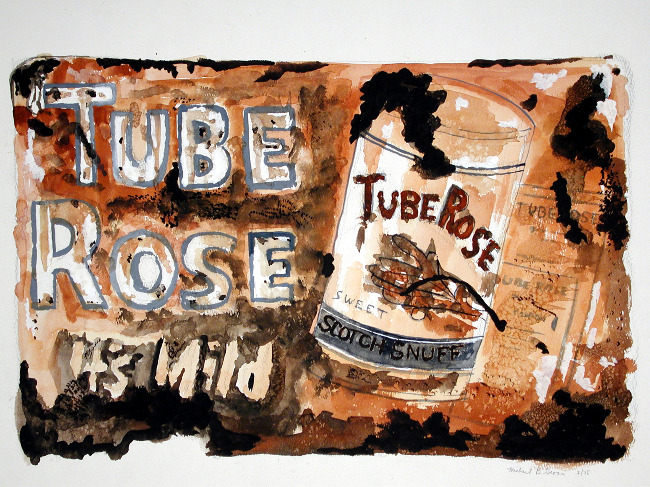William Christenberry

Tube Rose, 1975, Watercolor, 16.5 x 21 in.
On Michael Gross by William Christenberry
I usually don’t take private students but when Michael Gross and I met back in the early 70s, we started working together and had an immediate connection.
It wasn’t like Michael was a beginner. We didn’t have to begin with Drawing 101 and Color Theory. Michael was a sensitive, deep-feeling person, and that’s one reason we became friends as quickly as we did. What impressed me instantly was that Michael was never timid or reluctant to jump on something, unlike so many people I’d worked with over the years. From early on, he had the ability to just take off on something and immerse himself in it. When you look at his abstract, non-objective pieces — although so many of them are like landscapes to me – he was never unwilling or unable to make a move. That’s an impossible thing to teach someone. I think it was natural for Michael. In that way he was never really a student in my mind. We worked together.
I collect a lot of old signs and had this worn sign hanging near my worktable in the studio. One day Michael took it upon himself to make a painting of the sign – not a replica, but his own interpretation — quickly capturing the quality of that bent, rusted sign, and at the same time adding to it to become his own. I don’t like the word “style”; I just abhor that. Nobody – Joseph Albers, Hans Hoffman, or any of the great teachers — would say you can teach somebody a style. But Michael has always had his way of seeing, his way of expressing himself through drawing, and a unique gestural stroke. He explodes and generates some kind of excitement from what he’s seeing. There’s something innate within a person to have a way of looking at these works, past and present, and say “that’s Michael Gross”.
People who do not create art try to fit things neatly into an established structure or mold, but the belief that an artist is trained in representational work and then deviates and grows out of that to abstraction is not necessarily true. Michael saw things a certain way from the beginning, and had his own way of looking at the world, expressing himself, and allowing himself to be uninhibited. Somehow, for some reason, he always drew outside the lines, and had a powerful way of expressing himself, whether it was non-representational or realism and, as a result, was able to do both. The issue is not whether something is representational or non-representational, but the ability and the wherewithal to be on the attack, to be expressive, what ever the subject or non-subject might be.
One of Michael’s greatest strengths is his works on paper. The relationship between the drawings and the paintings is very distinct, and he’s been able to carry through that feeling of drawing to the canvas with amazing sensitivity. As a result, his paintings are filled with drawing. In his most recent painted monoprints, he is still drawing, but takes it a step further and begins to creep off the surface by putting new materials together, putting images together, over-lapping them, using photography – collaging both out-of-focus and detailed images – resulting in a move towards assemblage and mixed media.
I see my responsibility and my relationship with Michael now as a friend, a partner, and a fellow artist. We get together often; either he’ll come to my studio or I’ll go to his. There’s something that you cannot verbalize; there’s this sensibility that happens between two artists in the studio, one older, one younger, and between two people, two friends. We don’t always discuss why this or that is working or not — we’re beyond that point in our relationship. What benefits both Michael and me is that we talk about the other things that we see happening around us, and I think we share more of our ideas than we ever did in the past. Just going to each other’s studio is beneficial and I value that. It’s a rare gift to have another set of eyes you respect.
With this activity, this creative act called painting, there’s so much that goes into it, and in the end what happens on the canvas is ultimately the most important part of the process. So much goes into getting to that point, to be at that place… and then where do you go after you arrive? I don’t have a crystal ball, nor do I want one. I’m not going to predict what direction Michael may go because I know he will always continue to challenge himself. I have nothing but excitement about Michael’s work, both past and present, and I look forward to witnessing where it might go.